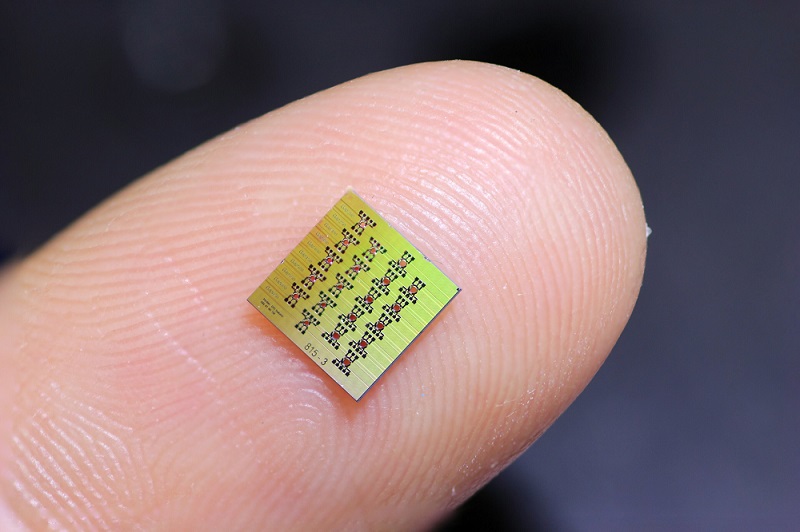A collaboration between École Polytechnique Féderalé de Lausanne and Purdue University has led to the development of an electrically driven, magnet-free optical isolator that enables light routing on a chip. Typically, optical isolation is achieved through the use of magnetic materials or magnetic fields. However, these are incompatible with current semiconductor foundry processes.
The researchers’ approach combines integrated photonics and micro-electromechanical systems technology, made using piezoelectric aluminum nitride monolithically integrated on ultralow-loss silicon nitride (Si3N4) photonic integrated circuits (PICs).

A fabricated piezoMEMS-silicon nitride chips containing multiple optical isolators. A fully CMOS-compatible hybrid semiconductor fabrication technique, developed by a team from EPFL and Purdue University, uses piezoelectric aluminum nitride that is monolithically integrated on PICs. Courtesy of EPFL.
By synchronously driving multiple piezoelectric microelectromechanical systems (MEMS) actuators, bulk acoustic waves are generated electromechanically, which can couple to and deflect light propagating in the Si3N4 waveguide below. The design created an effective rotating acoustic wave that allowed indirect interband transition in only one direction among a pair of strongly coupled optical modes.
This acousto-optical modulation, spatio-temporal modulation, mimics the effects of magnet-driven isolators. Replacing magnetic materials with piezoelectric thin-film transducers eliminated the need for a magnetic field.
Though magnet-free optical isolators have been introduced previously, the collaborative work produced the first that is driven electrically and operated in the linear optical regime. The study reports linear optical isolation of 10 dB, and experimental measurement of one-way, no-loss digital data transmission on an optical signal carrier.
The hybrid semiconductor fabrication technology is also fully CMOS-compatible and accessible via large-volume foundry processes, said Dr. Junqiu Liu, who leads the fabrication of Si3N4 chips at EPFL’s Center of MicroNanoTechnology.
The researchers anticipate the new optical isolators giving rise to new applications, including chip-scale atomic clocks, lidars, optical quantum computing, and on-chip spectroscopy. The researchers are working to create quantum coherent microwave-to-optic converters that could facilitate quantum interconnects between superconducting qubits, which requires conversion of single quanta of the microwave field to the optical domain, and vice versa.
The research was published in Nature Photonics (www.doi.org/10.1038/s41566-021-00882-z).